According to research from the World Federation of Advertisers, a whopping $50 billion USD is predicted to be wasted due to click fraud by 2025, and this figure is expected to increase. Click fraud is a significant cause of concern for websites utilizing Google AdWords and similar PPC ad platforms. Curious about Google’s actions and the methods they employ to Google Ads Click Fraud Prevention? The financial losses from click fraud are concerning, but fear not – Read the guide to find out!
What is Click Fraud?
Click fraud is a deceitful and malicious activity that involves clicking on online advertisements with the intent to exploit the advertiser.
In the context of Google Ads, click fraud specifically refers to the act of generating fraudulent clicks on ads, aimed at depleting the advertiser’s budget and potentially distorting campaign data. It can be perpetrated by various entities, including competitors, fraudulent advertisers, professional click fraud rings, click farms, and even unscrupulous website owners.
Approximately 17% of Google Ads traffic is thought to be click fraud. Cybercriminals abuse the Google Ads PPC model by deliberately clicking on adverts for products and services with no intention to buy – wiping out the advertiser’s budget as a result.
These fraudulent actors may encompass business rivals, individuals with malicious intent, bots, and click farms. At times, inadvertent clicks from users without malicious intent can result in significant costs. About 60% of mobile users click on ads due to accidental taps caused by “fat fingers.” Therefore, it is crucial to recognize these issues to minimize suspicious activities and enable your website to attract authentic clicks and traffic.
What are the victims of Google Ads Click Fraud?
Click fraud directly impacts these advertisers by depleting their advertising budgets through fraudulent clicks on their ads. As a result, their campaigns may achieve limited or no genuine engagement from potential customers, affecting their return on investment (ROI) and potentially distorting the performance data of their campaigns. This can lead to decreased effectiveness of their advertising efforts, financial losses, and diminished credibility in the online advertising space.
Furthermore, click fraud can indirectly affect the audience who may have been genuinely interested in the advertised products or services. Genuine potential customers may be unable to access the advertised content or may experience a decrease in the availability of relevant advertisements due to fraudulent activity consuming advertising budgets.
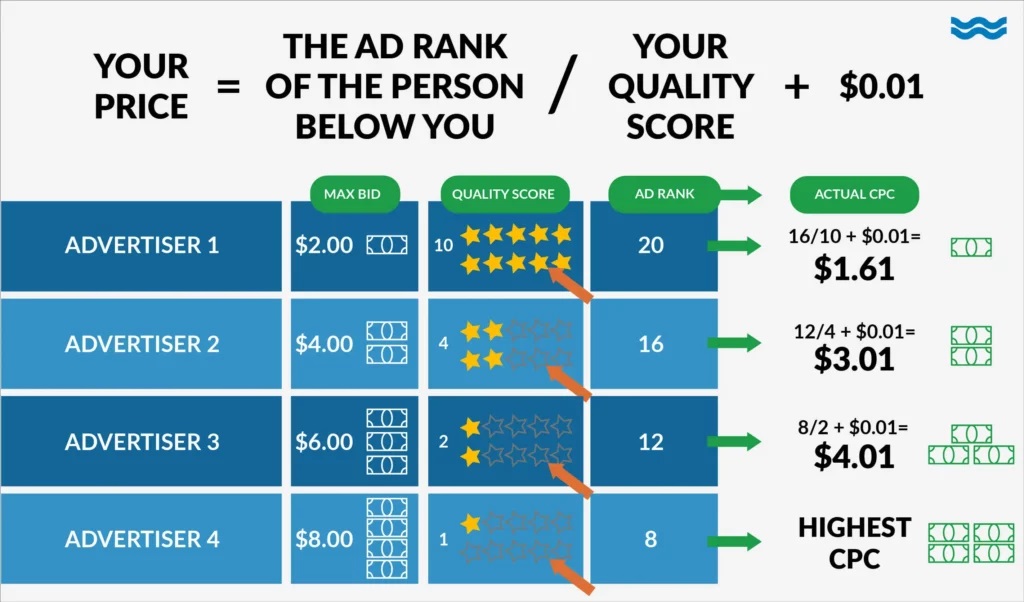
Types of Google Ads Click Fraud
For Google Ads click fraud prevention, it’s imperative to identify the common instigators behind this malicious activity. A comprehensive understanding of the behaviors exhibited by different fraudsters on the internet is essential for eradicating click fraud. Types of Google Ads click fraud include:
Competitor Click Fraud
This occurs when a competitor deliberately clicks on a rival’s ads to drain their advertising budget and hinder their campaign performance. It aims to deplete the competitor’s resources and potentially distort the advertising data for malicious purposes.
Bot Click Fraud
Bot traffic, generated by automated software programs (bots), can be used to click on ads, mimicking genuine user behavior. These bots are programmed to interact with online ads, leading to fraudulent clicks that skew campaign data and consume advertising budgets.
Click Farms and Manual Click Fraud
Click farms are operations where individuals, often hired for a nominal fee, manually click on ads repeatedly to generate high volumes of fraudulent clicks. This can inflate the number of clicks on an ad without any genuine interest from potential customers.
Ad Fraud Rings
Organized groups may engage in sophisticated click fraud schemes to generate fraudulent clicks on a large scale, aiming to defraud advertisers and manipulate the performance of ad campaigns for their gain.
Incentivized Click Fraud
Incentivized click fraud involves offering incentives, such as monetary rewards or other benefits, in exchange for clicking on ads. This practice results in artificially inflated click volumes and distorts the effectiveness of advertising campaigns.
Publisher Click Fraud
In some cases, website owners or publishers may engage in click fraud by clicking on their own ads to generate revenue from the advertiser without genuine user engagement.
Understanding these types of Google Ads click fraud is essential for advertisers in order to recognize and combat fraudulent activity effectively. Implementing proactive measures and leveraging available tools and resources are crucial steps in mitigating the impact of click fraud on advertising campaigns. Below, here are top 9 Google Ads click fraud prevention.

IP Exclusions for Google Ads Click Fraud Prevention
Implementing IP exclusions is a proactive strategy utilized by advertisers to prevent click fraud and enhance the effectiveness of Google Ads campaigns. IP exclusions allow advertisers to block specific IP addresses or ranges from seeing and clicking on their ads. This tactic helps to mitigate the impact of fraudulent clicks from certain sources, such as competitors, click farms, or other malicious entities.
Here’s how you can set up IP exclusions for click fraud prevention in Google Ads:
- Access your Google Ads Account: Log in to your Google Ads account to access the dashboard where you manage your advertising campaigns.
- Navigate to Settings: Click on the campaign you want to set up IP exclusions for, then navigate to the settings section within that campaign.
- Select “IP Exclusions”: Look for the option related to IP exclusions or advanced settings within the campaign settings menu.
- Add IP Addresses or Ranges: Enter the specific IP addresses or ranges that you want to exclude from seeing your ads. You can enter individual IP addresses (e.g., 192.168.1.1) or a range of IP addresses using CIDR notation (e.g., 192.168.1.0/24).
- Save Changes: Once you have added the necessary IP exclusions, save your changes to apply them to your campaign. Make sure to review and update these exclusions periodically to ensure they remain relevant and effective.
- Monitor Performance: Regularly monitor the performance of your Google Ads campaigns to assess the impact of the IP exclusions on mitigating click fraud. Analyze the data to see if there are improvements in click quality, conversion rates, and overall campaign effectiveness.
By setting up IP exclusions in Google Ads, advertisers can proactively protect their ad campaigns from fraudulent clicks originating from specific IP addresses or ranges. This targeted approach helps to minimize the negative effects of click fraud and optimize the ROI of advertising investments.
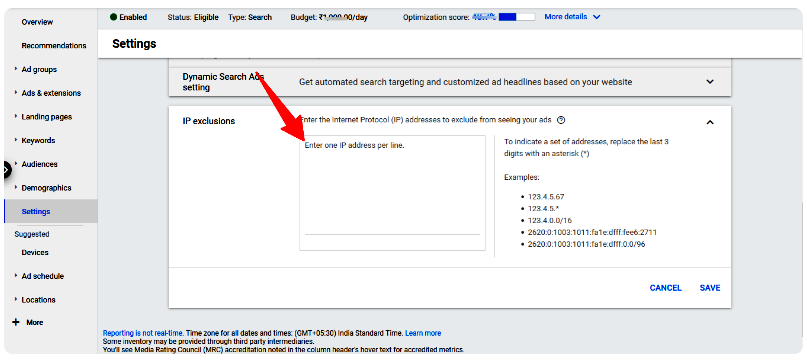
Block IP problematic address in Google Ads.
Monitor Timestamp
Tracking the timestamp of a user’s activities from their initial visit to your site until they engage in any action is crucial for safeguarding against fraud in Google AdWords. This is because users with malicious intent often click on ads to access your website without proceeding with any further actions. Therefore, blocking the IP address of such users is a recommended measure to shield your site from click fraud.
Use Google Analytics
Numerous website proprietors leverage the power of Google Analytics as a crucial tool in their arsenal for effective Google Ads click fraud prevention. Beyond assessing page performance and keyword efficacy, Google Analytics stands out in its ability to pinpoint repetitive ad clicks originating from suspicious IP addresses.
For an additional layer of vigilance against potential fraudulent activity, it’s advisable to regularly check your Google AdWords account. Navigate to the “Tools” section, and within the “Setup” window, click on “Billing and Payments.” Proceed to “View Transactions and Documents,” where you’ll find a detailed breakdown of all transactions, with a specific focus on identifying invalid clicks categorized under “Invalid Activity.”
By proactively utilizing these tools and closely monitoring your account, you can bolster your defenses against click fraud, ensuring optimal performance and cost-effectiveness in your advertising endeavors.
Choose Google Display Network Remarketing Campaigns
Undoubtedly, one of the most potent strategies for preventing Google Ads click fraud is through remarketing.
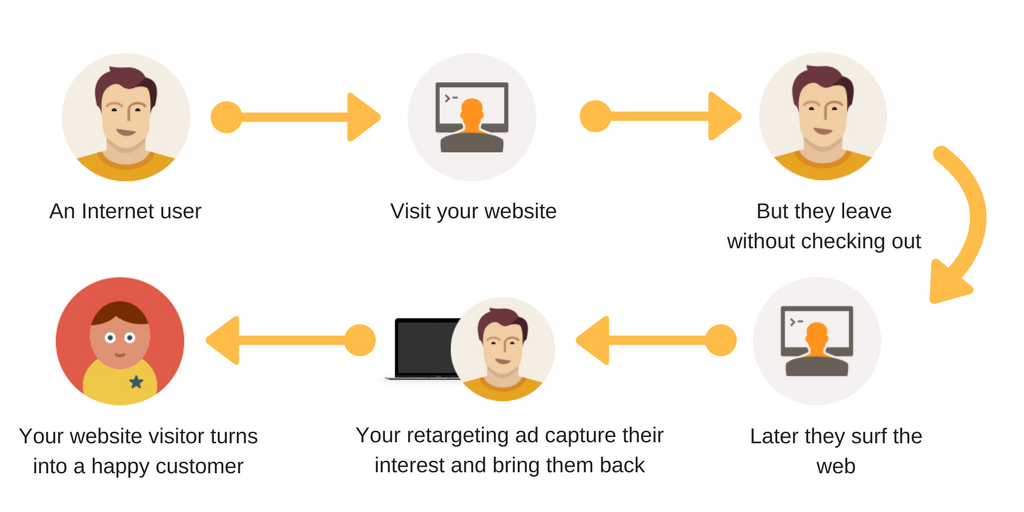
While it’s not impossible for conversions to occur immediately when visitors first use your site, it’s not highly probable. This is where retargeting and remarketing play a crucial role. You aim to reach customers who have either visited your site or similar ones. By doing so, publishers can effectively sidestep click fraud, as uninterested users won’t be exposed to these ads. Companies offering display marketing services can play a crucial role in implementing and managing this process.
Use specific PPC keywords for Google Ads Click Fraud Prevention
The best way to deal with click fraud is to minimize the damage caused by invalid clicks to your campaign. For optimal ROI, bid only on targeted keywords specific to your industry, as these will generate more relevant traffic, ensuring that the majority of clicks come from relevant advertisers and not from bots.
Regularly monitor user behavior
Minimizing click fraud begins with identifying it. If you want to eliminate invalid clicks and enhance the value of your advertising, review your PPC campaigns daily – that’s what you should do if you want to know which keywords and ads are delivering the best results.
Make sure to check user search behavior or the reasons behind the searches, including informative, navigational, and transactional user behaviors. If groups with similar behaviors include fraudulent clicks, pause your ads.
Ad Targeting
Adjusting ad targeting is an effective strategy for preventing click fraud in Google Ads. By refining your targeting parameters, you can minimize the risk of fraudulent clicks and ensure that your ads reach genuine and relevant audiences. Here’s how you can adjust your ad targeting to prevent click fraud:
- Refine Geographic Targeting: Narrow down the geographic locations where your ads are displayed. By focusing on regions where your target audience is located, you can reduce the exposure of your ads to potentially fraudulent clicks from irrelevant or malicious sources.
- Demographic Targeting: Utilize demographic targeting options, such as age, gender, and parental status, to tailor your ads to specific audience segments that are more likely to engage with your content legitimately.
- Device Targeting: Adjust your targeting based on the devices used by your target audience. You can prioritize certain devices or exclude others to align with the genuine behavior of your potential customers.
- Time and Day Targeting: Optimize the timing of your ad display by adjusting the scheduling to periods when your target audience is most active. This can help minimize exposure to fraudulent clicks during low-traffic or non-peak periods.
- Refine Audience Targeting: Utilize audience targeting options such as remarketing lists, similar audiences, and customer match to focus your ads on users who have already shown genuine interest in your products or services.
- Negative Keywords: Implement negative keywords to prevent your ads from being triggered by irrelevant search queries. This helps to ensure that your ads are shown to users who are genuinely interested in your offerings, reducing the likelihood of fraudulent clicks from unrelated searches.
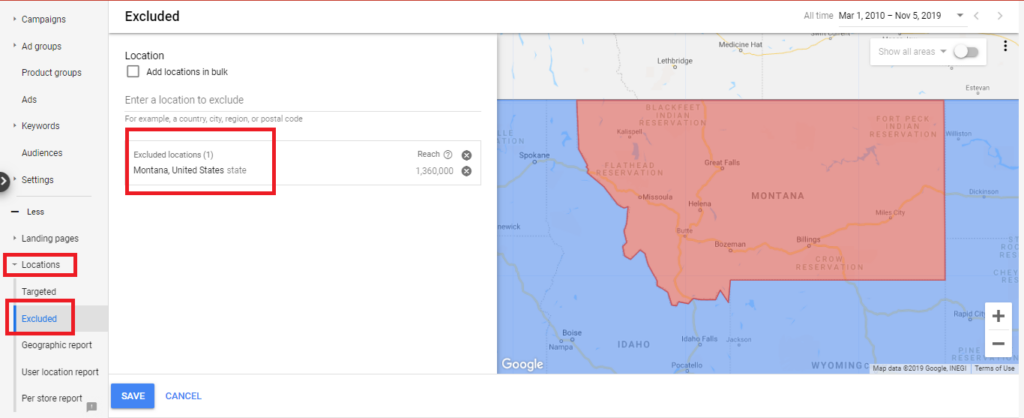
Formulate a Budget
Set a daily online marketing budget for your PPC advertising. This not only helps control click fraud in your Google Ads campaigns but also ensures that your spending remains under control.
Fraud Detection Software for Google Ads Click Fraud Prevention
Investing in fraud detection software is a robust approach to combat click fraud effectively. By leveraging specialized tools and services designed to identify and prevent fraudulent activity in online advertising, advertisers can enhance the security and performance of their campaigns.
Choosing robust fraud detection and prevention software can safeguard your PPC advertising. This software identifies users engaging in invalid clicks on your site by monitoring your Google Ads account and traffic, subsequently blocking fraudulent sources. Over time, this approach helps save money by preventing invalid charges and enhancing your conversion rates.
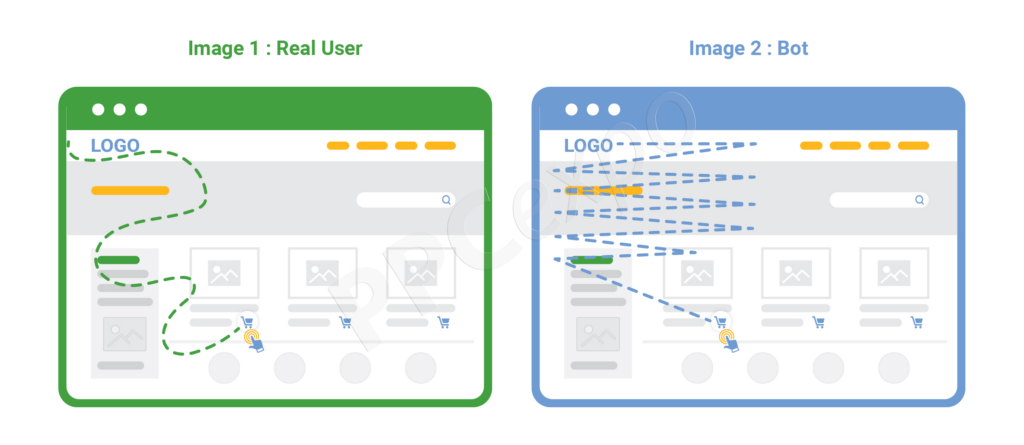
AI-based Click Fraud Protection Software
Ensuring effective Google Ads Click Fraud prevention is imperative for optimizing your advertising budget and maintaining trustworthy data. By maintaining continuous vigilance, utilizing available tools, and carefully monitoring campaign metrics, you can significantly mitigate the impact of click fraud. It’s important to keep in mind that taking a proactive approach to prevention serves as the most effective defense in this ongoing battle, playing a pivotal role in the success of your online advertising endeavors.
Contact us for the best support